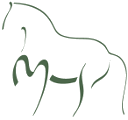The thickness of the snaffle
From time to another there is huge discussions about bit thickness. When I grow up in here in Sweden we where all looking at tho old “ardenner bits” (The most common draft horse in Sweden was called Ardenner) hanging in old farmer barns. The where mostly thinner than 1/2”, some times they were made of twinned wire, and for us kids they did look horrible and was a sign for us how mean the older generation were to their horses.
Back then in the 70th all us kids “know” that a bit shall not be to thin. Unfortunately no one told us what was the right thickness, just that it should not be to thin, so “everyone” bought the thickest bit they could find … Therefore there was a market for thick bits so the manufacturers made thicker and thicker bits. Standard became 5/8 – 3/4”, but you could buy bits up to 1” thickness, also for Shetland ponies.
In the 90th some Swedish veterinarians started to write about the danger with thick bits, and we learned that bits shall not be to thick. Unfortunately they didn't say what was right, just that they shouldn't be to thick. Suddenly everyone started to buy the thinnest bit they could find and it didn't take long before you could fins the old “ardenner bits” of twinned wire in shops again.
The last years I have seen that people have started to buy thicker bits. Now you can find 5/8” bits in the shops again.
So what is the correct thickness of a bit? I don't know and I don't think anyone else knows either.
If we shall search for a rule, I think we should start searching for maximal acceptable thickness of the bit. There must be some kind of limit where it gets uncomfortable for the horse. Maybe we can compare it with the size of a lollipop. How big can a lollipop be and we still can close the mouth while sucking it? 1/2”? 3/4”? The tongue is quite flexible and allows rather big things in the mouth without us feeling comfortable.
They say the horse's tongue isn't as flexible as our, but it is anyhow hard to say how thick bit a horse can accept as comfortable. If the bit is thicker than the gap between lower jaw and palate, it is to thick. But how do we know how big that gap is? It is quite hard to measure, so best is not to challenge to much.
Is there any benefit for the horse with a thick bit? Some say yes as the bit then has a bigger “contact area” in the mouth. Some say no as the jaw is straight and the bit is round so there will be a very small contact area anyhow. So who is right? I don't know. Probably none of them.
Those who say that the contact area with the jaw is almost the same on thin and thick bit are right, but they seem to forget the the bits probably has most contact with the tongue and the lips, not with the jaw. So how does a thick vs a thin bit affect the tongue and the lips? I don't know..
So what can we learn from this? Maybe that the riders are more hysteric about bit sizes than the horses are, and that there is more important things to discuss than bit thickness.
